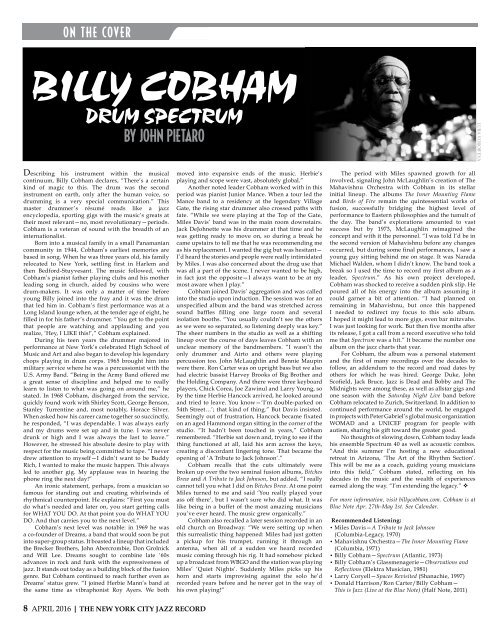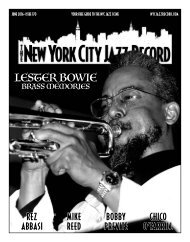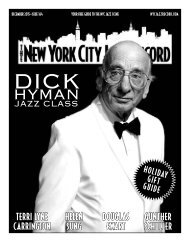You also want an ePaper? Increase the reach of your titles
YUMPU automatically turns print PDFs into web optimized ePapers that Google loves.
O N TH E COVER<br />
<strong>BILLY</strong> <strong>COBHAM</strong><br />
DRUM SPECTRUM<br />
by john pietaro<br />
Luba Vorob’eva<br />
Describing his instrument within the musical<br />
continuum, Billy Cobham declares, “There’s a certain<br />
kind of magic to this. The drum was the second<br />
instrument on earth, only after the human voice, so<br />
drumming is a very special communication.” This<br />
master drummer’s résumé reads like a jazz<br />
encyclopedia, sporting gigs with the music’s greats at<br />
their most relevant—no, most revolutionary—periods.<br />
Cobham is a veteran of sound with the breadth of an<br />
internationalist.<br />
Born into a musical family in a small Panamanian<br />
community in 1944, Cobham’s earliest memories are<br />
based in song. When he was three years old, his family<br />
relocated to New York, settling first in Harlem and<br />
then Bedford-Stuyvesant. The music followed, with<br />
Cobham’s pianist father playing clubs and his mother<br />
leading song in church, aided by cousins who were<br />
drum-makers. It was only a matter of time before<br />
young Billy joined into the fray and it was the drum<br />
that led him in. Cobham’s first performance was at a<br />
Long Island lounge when, at the tender age of eight, he<br />
filled in for his father’s drummer. “You get to the point<br />
that people are watching and applauding and you<br />
realize, ‘Hey, I LIKE this!’,” Cobham explained.<br />
During his teen years the drummer majored in<br />
performance at New York’s celebrated High School of<br />
Music and Art and also began to develop his legendary<br />
chops playing in drum corps. 1965 brought him into<br />
military service where he was a percussionist with the<br />
U.S. Army Band. “Being in the Army Band offered me<br />
a great sense of discipline and helped me to really<br />
learn to listen to what was going on around me,” he<br />
stated. In 1968 Cobham, discharged from the service,<br />
quickly found work with Shirley Scott, George Benson,<br />
Stanley Turrentine and, most notably, Horace Silver.<br />
When asked how his career came together so succinctly,<br />
he responded, “I was dependable. I was always early<br />
and my drums were set up and in tune. I was never<br />
drunk or high and I was always the last to leave.”<br />
However, he stressed his absolute desire to play with<br />
respect for the music being committed to tape. “I never<br />
drew attention to myself—I didn’t want to be Buddy<br />
Rich, I wanted to make the music happen. This always<br />
led to another gig. My applause was in hearing the<br />
phone ring the next day!”<br />
An ironic statement, perhaps, from a musician so<br />
famous for standing out and creating whirlwinds of<br />
rhythmical counterpoint. He explains: “First you must<br />
do what’s needed and later on, you start getting calls<br />
for WHAT YOU DO. At that point you do WHAT YOU<br />
DO. And that carries you to the next level.”<br />
Cobham’s next level was notable: in 1969 he was<br />
a co-founder of Dreams, a band that would soon be put<br />
into super-group status. It boasted a lineup that included<br />
the Brecker Brothers, John Abercrombie, Don Grolnick<br />
and Will Lee. Dreams sought to combine late ‘60s<br />
advances in rock and funk with the expressiveness of<br />
jazz. It stands out today as a building block of the fusion<br />
genre. But Cobham continued to reach further even as<br />
Dreams’ status grew. “I joined Herbie Mann’s band at<br />
the same time as vibraphonist Roy Ayers. We both<br />
moved into expansive ends of the music. Herbie’s<br />
playing and scope were vast, absolutely global.”<br />
Another noted leader Cobham worked with in this<br />
period was pianist Junior Mance. When a tour led the<br />
Mance band to a residency at the legendary Village<br />
Gate, the rising star drummer also crossed paths with<br />
fate. “While we were playing at the Top of the Gate,<br />
Miles Davis’ band was in the main room downstairs.<br />
Jack DeJohnette was his drummer at that time and he<br />
was getting ready to move on, so during a break he<br />
came upstairs to tell me that he was recommending me<br />
as his replacement. I wanted the gig but was hesitant—<br />
I’d heard the stories and people were really intimidated<br />
by Miles. I was also concerned about the drug use that<br />
was all a part of the scene. I never wanted to be high,<br />
in fact just the opposite—I always want to be at my<br />
most aware when I play.”<br />
Cobham joined Davis’ aggregation and was called<br />
into the studio upon induction. The session was for an<br />
unspecified album and the band was stretched across<br />
sound baffles filling one large room and several<br />
isolation booths. “You usually couldn’t see the others<br />
as we were so separated, so listening deeply was key.”<br />
The sheer numbers in the studio as well as a shifting<br />
lineup over the course of days leaves Cobham with an<br />
unclear memory of the bandmembers. “I wasn’t the<br />
only drummer and Airto and others were playing<br />
percussion too. John McLaughlin and Bennie Maupin<br />
were there. Ron Carter was on upright bass but we also<br />
had electric bassist Harvey Brooks of Big Brother and<br />
the Holding Company. And there were three keyboard<br />
players, Chick Corea, Joe Zawinul and Larry Young, so<br />
by the time Herbie Hancock arrived, he looked around<br />
and tried to leave. You know—‘I’m double-parked on<br />
54th Street…’; that kind of thing.” But Davis insisted.<br />
Seemingly out of frustration, Hancock became fixated<br />
on an aged Hammond organ sitting in the corner of the<br />
studio. “It hadn’t been touched in years,” Cobham<br />
remembered. “Herbie sat down and, trying to see if the<br />
thing functioned at all, laid his arm across the keys,<br />
creating a discordant lingering tone. That became the<br />
opening of ‘A Tribute to Jack Johnson’.”<br />
Cobham recalls that the cuts ultimately were<br />
broken up over the two seminal fusion albums, Bitches<br />
Brew and A Tribute to Jack Johnson, but added, “I really<br />
cannot tell you what I did on Bitches Brew. At one point<br />
Miles turned to me and said ‘You really played your<br />
ass off there’, but I wasn’t sure who did what. It was<br />
like being in a buffet of the most amazing musicians<br />
you’ve ever heard. The music grew organically.”<br />
Cobham also recalled a later session recorded in an<br />
old church on Broadway. “We were setting up when<br />
this surrealistic thing happened: Miles had just gotten<br />
a pickup for his trumpet, running it through an<br />
antenna, when all of a sudden we heard recorded<br />
music coming through his rig. It had somehow picked<br />
up a broadcast from WBGO and the station was playing<br />
Miles’ ‘Quiet Nights’. Suddenly Miles picks up his<br />
horn and starts improvising against the solo he’d<br />
recorded years before and he never got in the way of<br />
his own playing!”<br />
The period with Miles spawned growth for all<br />
involved, signaling John McLaughlin’s creation of The<br />
Mahavishnu Orchestra with Cobham in its stellar<br />
initial lineup. The albums The Inner Mounting Flame<br />
and Birds of Fire remain the quintessential works of<br />
fusion, successfully bridging the highest level of<br />
performance to Eastern philosophies and the tumult of<br />
the day. The band’s explorations amounted to vast<br />
success but by 1973, McLaughlin reimagined the<br />
concept and with it the personnel. “I was told I’d be in<br />
the second version of Mahavishnu before any changes<br />
occurred, but during some final performances, I saw a<br />
young guy sitting behind me on stage. It was Narada<br />
Michael Walden, whom I didn’t know. The band took a<br />
break so I used the time to record my first album as a<br />
leader, Spectrum.” As his own project developed,<br />
Cobham was shocked to receive a sudden pink slip. He<br />
poured all of his energy into the album assuming it<br />
could garner a bit of attention. “I had planned on<br />
remaining in Mahavishnu, but once this happened<br />
I needed to redirect my focus to this solo album.<br />
I hoped it might lead to more gigs, even bar mitzvahs.<br />
I was just looking for work. But then five months after<br />
its release, I got a call from a record executive who told<br />
me that Spectrum was a hit.” It became the number one<br />
album on the jazz charts that year.<br />
For Cobham, the album was a personal statement<br />
and the first of many recordings over the decades to<br />
follow, an addendum to the record and road dates by<br />
others for which he was hired. George Duke, John<br />
Scofield, Jack Bruce, Jazz is Dead and Bobby and The<br />
Midnights were among these, as well as allstar gigs and<br />
one season with the Saturday Night Live band before<br />
Cobham relocated to Zurich, Switzerland. In addition to<br />
continued performance around the world, he engaged<br />
in projects with Peter Gabriel’s global music organization<br />
WOMAD and a UNICEF program for people with<br />
autism, sharing his gift toward the greater good.<br />
No thoughts of slowing down, Cobham today leads<br />
his ensemble Spectrum 40 as well as acoustic combos.<br />
“And this summer I’m hosting a new educational<br />
retreat in Arizona, ‘The Art of the Rhythm Section’.<br />
This will be me as a coach, guiding young musicians<br />
into this field,” Cobham stated, reflecting on his<br />
decades in the music and the wealth of experiences<br />
earned along the way. “I’m extending the legacy.” v<br />
For more information, visit billycobham.com. Cobham is at<br />
Blue Note Apr. 27th-May 1st. See Calendar.<br />
Recommended Listening:<br />
• Miles Davis—A Tribute to Jack Johnson<br />
(Columbia-Legacy, 1970)<br />
• Mahavishnu Orchestra—The Inner Mounting Flame<br />
(Columbia, 1971)<br />
• Billy Cobham—Spectrum (Atlantic, 1973)<br />
• Billy Cobham’s Glassmenagerie—Observations and<br />
Reflections (Elektra Musician, 1981)<br />
• Larry Coryell—Spaces Revisited (Shanachie, 1997)<br />
• Donald Harrison/Ron Carter/Billy Cobham—<br />
This is Jazz (Live at the Blue Note) (Half Note, 2011)<br />
8 APRIL 2016 | THE NEW YORK CITY JAZZ RECORD




